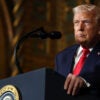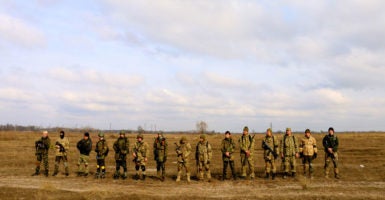KYIV, Ukraine—Ukrainian troops are slowly advancing in the country’s eastern war zone, testing the limits of a shaky stalemate in the five-year-old conflict against Russia and its separatist proxies.
In the last year, Ukrainian military forces retook 24 square kilometers (about 9.3 square miles) of territory in the country’s embattled Donbas region, officials said, underscoring the slow and steady progress of a so-called creeping offensive that dates back to late 2016.
“It is impossible to win the war by defending, you need to counterattack and push your opponent along the whole line of delimitation, otherwise the enemy will easily move forward and seize our positions,” Serhii Morugin, a Ukrainian conflict journalist who has reported from the Donbas war zone, told The Daily Signal.
The leaders of Ukraine, Russia, France, and Germany negotiated a February 2015 cease-fire, known as Minsk II, which locked the war in eastern Ukraine along a relatively static, roughly 250-mile-long front line. The deal also required both sides to pull weapons with calibers above 100 mm back from the contact line.
Nevertheless, the Donbas conflict is ongoing and has killed more than 13,000 Ukrainians, according to United Nations estimates. Of that number, more than half have died since Minsk II went into effect.
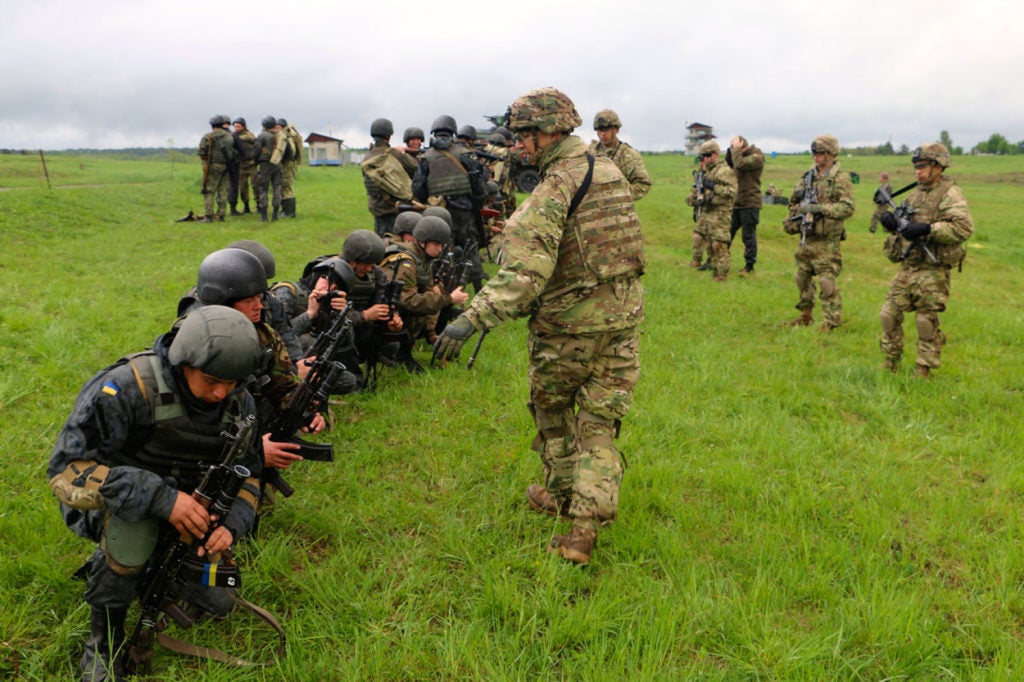
The U.S. Army’s training mission in western Ukraine has been ongoing since 2015. (Photos: Nolan Peterson/The Daily Signal)
Today, about 60,000 Ukrainian troops are deployed to the Donbas war zone where they remain hunkered down in trenches and ad hoc forts opposite about 38,000 combined Russian-separatist troops—a force funded and financed by Moscow, which includes roughly 3,000 Russian regulars, Ukrainian military officials say.
Wary of heavy casualties, as well as the imposing prospect of spurring a Russian counteroffensive, Ukrainian forces have advanced in fits and starts over the past few years, mostly relying on small-unit raids to take pockets of territory and overrun isolated enemy positions.
Ukrainians recaptured the town of Shyrokyne on the Sea of Azov in 2016. Then, beginning in early 2017, Ukrainian forces intermittently recaptured a string of settlements, notably around the combined Russian-separatist strongholds of Horlivka and Donetsk. Ukrainian military personnel refer to this glacial, cautious advance as a “creeping offensive.”
‘Intolerable’
At the cost of about 100 soldiers killed in action, Ukraine’s territorial gains over the past year are roughly equivalent to one-quarter the acreage of the Walt Disney World Resort in Florida.
These incremental advances aren’t enough to turn the conflict’s tide in Ukraine’s favor, but the moves could spur Russia to retaliate, some experts and officials warn. However, others argue the offensive operations are needed to boost Ukrainian troops’ morale, cut down on smuggling across the front lines, and help square the real-world battlefield map with the front-line geography laid down by the Minsk II negotiations more than four years ago.
“Of course, there is a risk [of Russian escalation], in addition to more casualties of Ukrainian soldiers,” said Oleksiy Melnyk, a former Soviet fighter pilot who is now co-director of foreign relations and international security programs at the Kyiv-based Razumkov Center think tank.
“However, it is important to emphasize that even if these actions may be considered as cease-fire violations, [they] do not violate the agreed-upon separation line,” Melnyk said.
A key part of Ukraine’s strategy has been to occupy tracts of territory within no man’s land—colloquially known as the “gray zone” among troops.
At some places, opposing forces are separated by several kilometers of no man’s land, with each camp hunkering down in defensible positions that offer the best natural protection from shelling and sniper fire.
Outside the town of Novomykhailivka, Ukrainian dugouts were located at the edge of a wood line before a flat expanse of shrubland, which offered little cover or concealment. The combined Russian-separatist positions were on a far-off rise, unseen to the naked eye, the Ukrainian soldiers explained to this correspondent. Advancing into no man’s land at this location would be a dangerous endeavor, exposing the troops to indirect fire with scant protection.
Yet, despite the increased exposure to enemy fire, Ukrainian units have pressed forward into no man’s land at multiple locations over the past year, achieving “a tactical advantage at some spots,” said Melnyk, the former Soviet fighter pilot and think tank expert.
As the Ukrainians advance, the distance to their enemies has narrowed to within dozens of meters at some places—close enough to shout verbal insults to the other side.
“The positions of the parties are converging,” Morugin said, adding that the status quo of immobile, trench warfare is “psychologically intolerable” for Ukrainian troops.
“For five years, the army has grown tired of defensive actions,” Morugin said. “It’s psychologically important to release every meter of Ukrainian land, even if such attacks and counterattacks are associated with high losses.”
Diplomatic Tightrope
Russian President Vladimir Putin has accused Ukraine of violating the Minsk II cease-fire. Ukrainian officials, however, say the territory they’ve recaptured should have been under Ukrainian government control, anyway, according to the agreement.
During a recent visit to the war zone, outgoing Ukrainian President Petro Poroshenko said the territorial gains did not violate the cease-fire’s rules.
“We are clearly aware that Russia has not abandoned its aggressive intentions, and our state, unfortunately, is still in danger,” Poroshenko said during a May 6 speech to front-line soldiers, according to a readout published to the presidential administration’s website.
“The enemy must know clearly that any attempts to undermine our frontiers will be doomed to failure,” Poroshenko said.
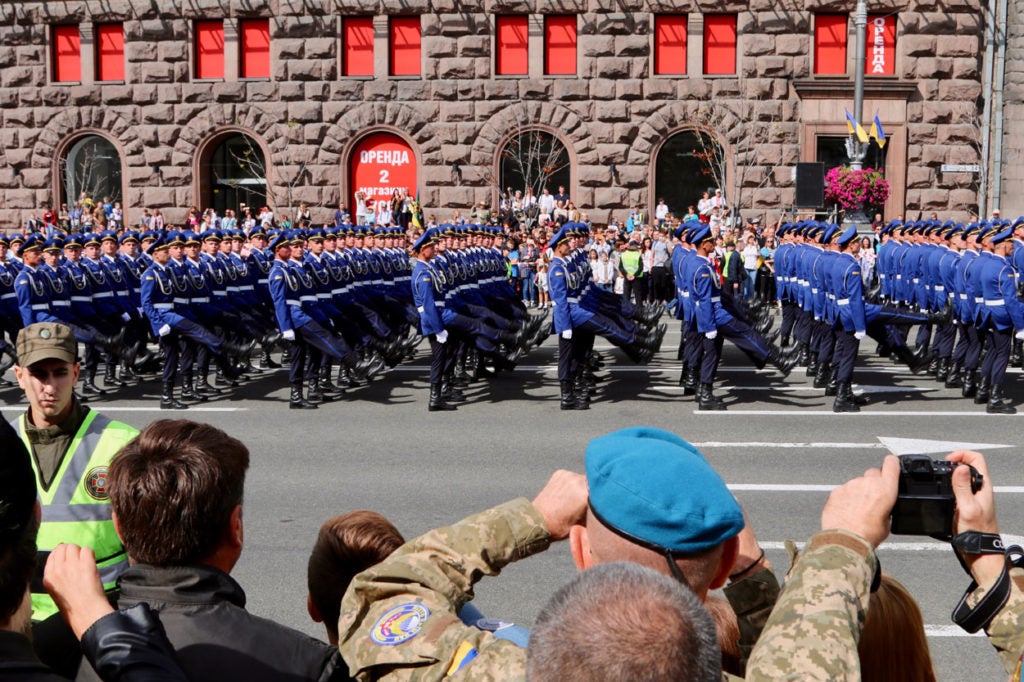
Since 2014, Ukraine has rebuilt its military into a formidable fighting force.
Volodymyr Zelensky, a comedian and TV star with no political experience, defeated Poroshenko by a landslide in an April 21 presidential runoff. Zelensky said during his campaign that he’s unwilling to press an end to the Donbas conflict with military force, and left the door open for peace talks with Putin.
“We will continue with the Minsk talks, we will reboot them,” Zelensky said during his election night victory speech.
Putin, for his part, said he’s open to dialogue with the new Ukrainian president.
“If we ever meet in order to hold talks—and I don’t rule out such a possibility—we will first and foremost have to discuss ways to end the conflict in southeastern Ukraine,” Putin said at an April 27 press conference in Beijing, the Russian news agency TASS reported.
No Military Solution
There’s little enthusiasm in Kyiv for ramping up combat operations to bring the war to a quick and decisive conclusion. A major Ukrainian offensive to retake the entire Donbas territory would exact a heavy toll in civilian and military casualties and wreak havoc on the infrastructure of a region already scarred by five years of war. Also, such a move would likely spur Russia to escalate the conflict or invade, experts say.

A memorial to the fallen on the Ukrainian side of no man’s land outside the town of Novomykhailivka in eastern Ukraine.
It’s so far unclear whether Zelensky will halt the creeping offensive strategy for the sake of a negotiated peace deal with Moscow. While the consensus opinion among Ukrainian politicians and military brass is that there is no military solution to the conflict, the prospect of diplomatic compromises with Russia risks domestic backlash.
Many Ukrainian soldiers remain skeptical of diplomacy with the Russian president.
“Any negotiations with Putin are a deal with the devil. We already have the Minsk agreement, and should move to it. There is nothing more to negotiate,” said Oleksiy Bobovnikov, an officer in the Ukrainian army. “Any compromises with Russia means their victory, and heavy losses to Ukraine.”
Volodymyr Sheredeha, a combat veteran of the pro-Ukraine Dnipro-1 volunteer battalion, was similarly skeptical of peace talks with with Russia.
“All diplomatic negotiations and agreements can’t resolve the conflict, because there does not exist, and won’t exist, real consensus between the two sides,” Sheredeha said. “That way can only lead to an eternally frozen conflict, regularly igniting and calming down combat from time to time, again and again, like we have seen for the past four years.”
New Name, Old War
In 2018, Ukraine rebranded its war effort. The “Anti-Terrorist Operation” became the “Joint Forces Operation,” or JFO.
A parliamentary law approving the measure formally labeled Russia as the “aggressor country” and dictated an administrative shake-up in which the military took overall control of the war effort, subordinating the role of the Security Service of Ukraine, or SBU.
Despite the name change, the daily rhythm of combat along the trench lines in eastern Ukraine remains similar in nature to that of the Western front in World War I—although on a much smaller scale and with some technological perks, such as the use of drones and electronic warfare.
It’s a bizarre conflict in which the opposing camps are essentially sitting in place, weathering daily artillery and sniper fire without trying to achieve a strategically significant breakthrough.
Psychologically, it’s a tough war. There’s simply no escaping the danger—the artillery can start at any time and the sniper threat is never-ending. In the end, a soldier’s chances of survival depend on good luck and the odds of not being in the wrong place at the wrong time.
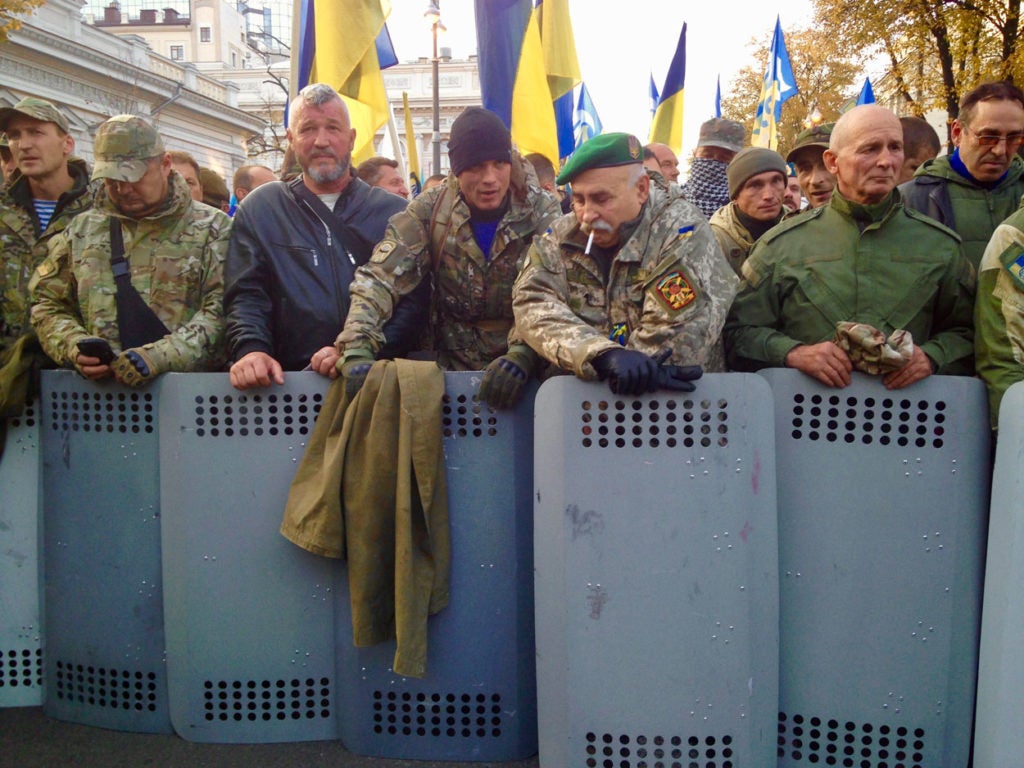
Many Ukrainian veterans remain skeptical of peace talks with Russia.
Outside the war zone, life goes on relatively as normal across Ukraine. Still, the conflict constantly teeters on the edge of escalating into a much bigger and far deadlier cataclysm.
Moscow has deployed about 80,000 troops along Ukraine’s borders capable of launching a rapid, armored invasion within two to four weeks, current and former Ukrainian defense officials say.
Within the two breakaway territories in the Donbas, combined Russian-separatist forces maintain a force of roughly 700 tanks, of which about 500 are operational, according to Ukrainian military officials. That’s about three times more operational tanks than the number currently possessed by the United Kingdom, according to data from Jane’s 360.
An additional 40,000 Russian troops are currently garrisoned in Crimea, along with missiles and bombers capable of striking mainland Ukraine.
With so much Russian combat power amassed on Ukraine’s borders, there are some in Ukraine who say the creeping offensive strategy is too risky.

Since 2016, the Ukrainian military has carried out a “creeping offensive” in the country’s eastern war zone.
Andrii Telizhenko, a former Ukrainian diplomat to the U.S. who is critical of Poroshenko, condemned the creeping offensive as a “very dangerous” gambit made for “political propaganda motives.” Yet, despite his misgivings, Telizhenko also acknowledged the need for some element of dynamism in Ukraine’s long-term war planning for the sake of preserving soldiers’ morale.
“The military in a war zone cannot stand static, or it will demoralize. So it was also necessary for Kyiv to take action on taking new ground to please the psychological and patriotic moods of the soldiers who are in the [war zone], not in the best conditions, and are being killed almost every day,” Telizhenko said.
‘The New Armed Forces’
This month more than 130 troops from the U.S. Army’s 101st Airborne Division deployed to a base in western Ukraine, taking the reigns of a U.S. mission to train Ukrainian troops that dates back to 2015. The United Kingdom and Canada also maintain long-standing training missions in Ukraine.
With Western help, Ukraine’s armed forces have moved away from the strict, top-down Soviet chain of command structure, adopting in its place a more Western approach to military leadership, which empowers troops to be more autonomous in combat.
Today, Ukraine’s combat forces are more nimble and able to react to battlefield realities without relying on play-by-play micromanagement from commanders safely ensconced behind the front lines.
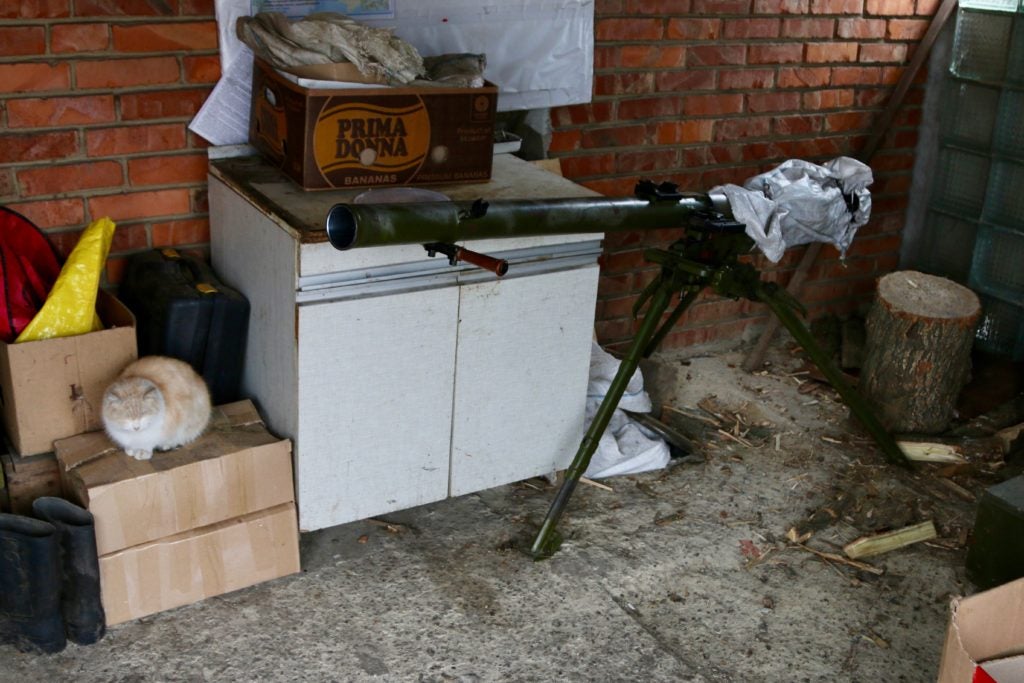
In eastern Ukraine, war has become a way of life.
Still, many Ukrainian soldiers complain about burdensome paperwork and a military bureaucracy run amok, underscoring how the daily grind of managing a frozen, low-intensity war—in which combat loses its urgency and becomes a business-like affair—can be just as harmful to morale as the perpetual danger.
“We have a long road ahead of us,” Bobovnikov said. “But comparing where we are in 2019 with where we were in 2014, it’s more than just a huge step forward—it’s some kind of giant leap.”


